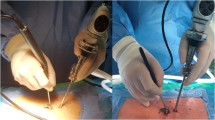Abstract
Background
Unilateral biportal endoscopic lumbar interbody fusion (ULIF) with one cage results in fewer definitive fusions (Park et al. in Neurosurg Rev 42(3):753–761, 2019). We succeeded in inserting bilateral cages during ULIF.
Method
We attempted posterior ULIF for degenerative lumbar spondylolisthesis with bilateral recess stenosis. With the help of a third portal, ULIF with bilateral cage insertion was performed under general anaesthesia.
Conclusions
We successfully performed ULIF with bilateral cages with the help of a third portal. This procedure may be an alternative for treating lumbar stenosis with instability.




Similar content being viewed by others
References
Heo DH, Eum JH, Jo JY, Chung H (2021) Modified far lateral endoscopic transforaminal lumbar interbody fusion using a biportal endoscopic approach: technical report and preliminary results. Acta Neurochir 163(4):1205–1209. https://doi.org/10.1007/s00701-021-04758-7
Heo DH, Park CK (2019) Clinical results of percutaneous biportal endoscopic lumbar interbody fusion with application of enhanced recovery after surgery. Neurosurg Focus 46(4):E18. https://doi.org/10.3171/2019.1.FOCUS18695
Lee YH, Chung CJ, Wang CW, Peng YT, Chang CH, Chen CH, Chen YN, Li CT (2016) Computational comparison of three posterior lumbar interbody fusion techniques by using porous titanium interbody cages with 50% porosity. Comput Biol Med 71:35–45. https://doi.org/10.1016/j.compbiomed.2016.01.024
Lee JH, Lee JH, Yoon KS, Kang SB, Jo CH (2008) Comparative study of unilateral and bilateral cages with respect to clinical outcomes and stability in instrumented posterior lumbar interbody fusion. Neurosurgery 63(1):109–114. https://doi.org/10.1227/01.NEU.0000335077.62599.F0
Lynch CP, Cha E, Rush Iii AJ, Jadczak CN, Mohan S, Geoghegan CE, Singh K (2021) Outcomes of transforaminal lumbar interbody fusion using unilateral versus bilateral interbody cages. Neurospine 18(4):854–862. https://doi.org/10.14245/ns.2142248.124
Park MK, Park SA, Son SK, Park WW, Choi SH (2019) Clinical and radiological outcomes of unilateral biportal endoscopic lumbar interbody fusion (ULIF) compared with conventional posterior lumbar interbody fusion (PLIF): 1-year follow-up. Neurosurg Rev 42(3):753–761. https://doi.org/10.1007/s10143-019-01114-3
Funding
This work was supported by the National Key R&D Program of China (2019YFC0121400).
Author information
Authors and Affiliations
Corresponding author
Ethics declarations
Ethics approval and consent to participate
This study protocol was approved by the Research Ethics Board of our hospital. The patient signed a written informed consent form for enrolment in this study.
Conflict of interest
The authors declare no competing interests.
Additional information
Publisher's note
Springer Nature remains neutral with regard to jurisdictional claims in published maps and institutional affiliations.
Key points
1. We successfully performed ULIF with bilateral cages using a biportal endoscopic posterior approach with the help of a third portal.
2. Compared with conventional standard PLIF, the benefits of ULIF with bilateral cages included the preservation of the muscles and ligaments, reduced transfusion requirements [4], and enhanced postoperative recovery [2].
3. Zhang’s portal was designed over the base of the contralateral SAP, which provided accessibility to decompress the recess and implant the cage.
4. Through Zhang’s portal, surgical tools can be used perpendicular to the spine so that contralateral decompression is not blocked by the base of the spinous process, allowing a more convenient and flexible operation (Fig.
a The Kerrison punch is blocked by the base of the spinous process; b Through Zhang’s portal, an efficient contralateral decompression can be achieved; c The forceps cannot resect the contralateral LF because of obstruction of the base of the spinous process; d Through Zhang’s portal, the contralateral LF can be removed easily
5).
5. Contralateral decompression can also cause adhesion lysis, which is helpful for reduction in lumbar spondylolisthesis.
6. When inserting the contralateral cage, a retractor should be inserted through the working portal to protect the contralateral traversing nerve root.
7. The quarterback K portal was placed only at the junction of the inferior lamina of the superior vertebrae and the base of the spinous process. A Kirschner wire was used as a root retractor through the quarterback K portal and did not hinder the use of the surgical instruments in the working portal, increasing the safety of the procedure and the comfort of the assistant.
8. The Kirschner wire should not be inserted too deep to prevent damage to the abdominal organs.
9. After inserting the contralateral cage, it is necessary to confirm its location through endoscopy and fluoroscopy.
10. Bilateral drainage tubes should be inserted through the quarterback K portal and Zhang’s portal to avoid epidural haematoma.
This article is part of the Topical Collection on Spine degenerative
Supplementary information
Below is the link to the electronic supplementary material.
Supplementary file1 (MP4 54376 KB)
Rights and permissions
Springer Nature or its licensor holds exclusive rights to this article under a publishing agreement with the author(s) or other rightsholder(s); author self-archiving of the accepted manuscript version of this article is solely governed by the terms of such publishing agreement and applicable law.
About this article
Cite this article
Zhu, C., Zhang, L., Pan, H. et al. Lumbar interbody fusion with bilateral cages using a biportal endoscopic technique with a third portal. Acta Neurochir 164, 2343–2347 (2022). https://doi.org/10.1007/s00701-022-05324-5
Received:
Accepted:
Published:
Issue Date:
DOI: https://doi.org/10.1007/s00701-022-05324-5





